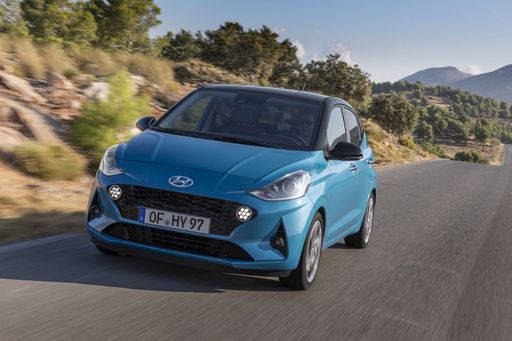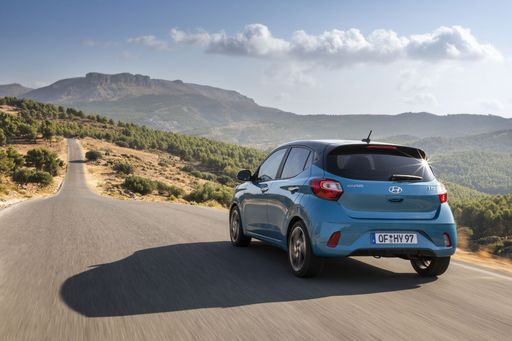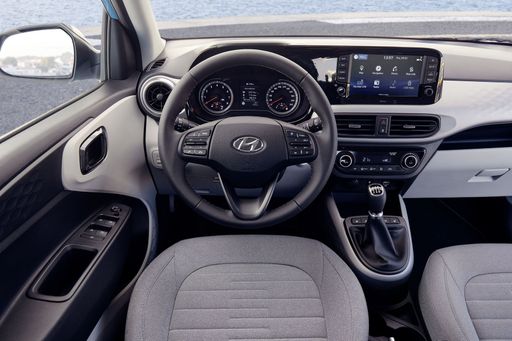Citroen Ami VS Hyundai i10 – Specs, Efficiency & Price Comparison
Which model is the better choice – the Citroen Ami or the Hyundai i10? We compare performance (8 HP vs 90 HP), boot capacity (63 L vs 252 L), efficiency ( vs 4.90 L), and of course, the price (6800 £ vs 14600 £).
Find out now which car fits your needs better!
The Citroen Ami (Hatchback) is powered by a Electric engine and comes with a Automatic transmission. In comparison, the Hyundai i10 (Hatchback) features a Petrol engine and a Manuel or Automatic gearbox.
When it comes to boot capacity, the Citroen Ami offers 63 L, while the Hyundai i10 provides 252 L – depending on what matters most to you. If you’re looking for more power, you’ll need to decide whether the 8 HP of the Citroen Ami or the 90 HP of the Hyundai i10 suits your needs better.
There are also differences in efficiency: vs 4.90 L. In terms of price, the Citroen Ami starts at 6800 £, while the Hyundai i10 is available from 14600 £.
Compare all the key specs now and find out which model fits your lifestyle best!
Citroen Ami
The Citroen Ami is a distinctive electric microcar that has captured the attention of urban commuters with its compact design and eco-friendly credentials. Its unique boxy shape and minimalist interior appeal to those seeking a practical and sustainable solution for city driving. As an affordable and innovative mobility option, the Ami is perfect for navigating tight spaces and making short trips with ease.
detailsHyundai i10
The Hyundai i10 impresses with its compact design, making it an ideal choice for navigating through busy urban environments. Its interior is surprisingly spacious, offering drivers and passengers comfort beyond what one might expect from a city car. The model combines efficiency and practicality, making it an attractive option for those seeking both economy and functionality in their daily commute.
details @ hyundai.news
@ hyundai.news
 @ hyundai.news
@ hyundai.news
 @ hyundai.news
@ hyundai.news
 @ hyundai.news
@ hyundai.news
 @ hyundai.news
@ hyundai.news

|
|
|
|
|
Costs and Consumption |
|
|---|---|
|
Price
6800 - 8200 £
|
Price
14600 - 19000 £
|
|
Consumption L/100km
-
|
Consumption L/100km
4.9 - 5.5 L
|
|
Consumption kWh/100km
-
|
Consumption kWh/100km
-
|
|
Electric Range
75 km
|
Electric Range
-
|
|
Battery Capacity
5.40 kWh
|
Battery Capacity
-
|
|
co2
0 g/km
|
co2
110 - 124 g/km
|
|
Fuel tank capacity
-
|
Fuel tank capacity
36 L
|
Dimensions and Body |
|
|---|---|
|
Body Type
Hatchback
|
Body Type
Hatchback
|
|
Seats
2
|
Seats
4 - 5
|
|
Doors
2
|
Doors
5
|
|
Curb weight
470 - 483 kg
|
Curb weight
996 - 1099 kg
|
|
Trunk capacity
63 L
|
Trunk capacity
252 L
|
|
Length
2460 mm
|
Length
3670 - 3675 mm
|
|
Width
1390 mm
|
Width
1680 mm
|
|
Height
1525 mm
|
Height
1480 - 1483 mm
|
|
Payload
217 - 230 kg
|
Payload
344 - 423 kg
|
Engine and Performance |
|
|---|---|
|
Engine Type
Electric
|
Engine Type
Petrol
|
|
Transmission
Automatic
|
Transmission
Manuel, Automatic
|
|
Transmission Detail
Reduction Gearbox
|
Transmission Detail
Schaltgetriebe, Automatisiertes Schaltgetriebe
|
|
Drive Type
Front-Wheel Drive
|
Drive Type
Front-Wheel Drive
|
|
Power HP
8 HP
|
Power HP
63 - 90 HP
|
|
Acceleration 0-100km/h
-
|
Acceleration 0-100km/h
11.4 - 18.4 s
|
|
Max Speed
45 km/h
|
Max Speed
143 - 175 km/h
|
|
Torque
40 Nm
|
Torque
93 - 172 Nm
|
|
Number of Cylinders
-
|
Number of Cylinders
3 - 4
|
|
Power kW
6 kW
|
Power kW
46 - 66 kW
|
|
Engine capacity
-
|
Engine capacity
998 - 1197 cm3
|
General |
|
|---|---|
|
Model Year
2025
|
Model Year
2024
|
|
CO2 Efficiency Class
A
|
CO2 Efficiency Class
C, D
|
|
Brand
Citroen
|
Brand
Hyundai
|
Citroen Ami
The Revolutionary Design of the Citroen Ami
The Citroen Ami represents a paradigm shift in urban mobility with its unique design and innovative features. As a compact city vehicle, the Ami embraces a minimalist aesthetic with its quirky and symmetrical design. Measuring just 2,410 mm in length, the Ami is tailored for navigating tight city streets with ease while its efficient use of space offers practicality for daily commutes.
Technical Specifications: A Powertrain Built for the City
The Citroen Ami is powered by an electric motor that delivers 8 PS and approximately 6 kW. This motor, paired with a front-wheel-drive system and an automatic transmission fitted with a simple but effective reduction gearbox, offers straightforward operation ideal for city driving. The Ami boasts a torque of 44 Nm, ensuring zippy performance at lower speeds.
Electric Efficiency and CO2 Neutrality
One of the standout features of the Citroen Ami is its CO2 efficiency. As an electric vehicle, it emits no CO2, aligning itself with modern environmental standards. The vehicle's efficiency is further highlighted by its energy consumption, with a battery capacity of 5.4 kWh that grants the Ami a range of up to 75 km on a single charge. These capabilities position it as a frontrunner in CO2-Effizienzklasse A.
Compact Dimensions and Practicality
Built for the urban environment, the Ami's compact dimensions—2,410 mm in length, 1,388 mm in width, and 1,525 mm in height—make it exceptionally manoeuvrable. With a maximum speed of 45 km/h, it is designed for efficiency rather than speed. Despite its size, the Ami provides a surprisingly spacious interior with seating for two and a 63-litre storage capacity, cleverly making the most of its architectural space.
Cost-Effective Urban Transport
The Citroen Ami stands out not only for its design but also for its affordability. With a price range between €7,990 and €8,990, it offers a cost-effective solution for individuals seeking efficient city transport without compromising on style or eco-friendliness.
Model Year and Trim Options
The 2024 Citroen Ami is offered in attractive trim options such as Colour and Peps, providing customisation choices to suit a variety of tastes. These options add a personal touch to its already appealing minimalist design.
In conclusion, the Citroen Ami offers a fresh perspective on urban commuting with its innovative design and sustainable features. It's perfectly positioned to make a substantial impact on eco-friendly urban transport.
Hyundai i10
Introduction to the Hyundai i10
The Hyundai i10 has consistently proven to be a dependable and stylish companion for urban driving. Known for its compact design and efficiency, this hatchback offers a perfect blend of modern aesthetics and practicality, making it a popular choice for city dwellers and small families alike.
Performance and Efficiency
The Hyundai i10 is available with both manual and automatic transmissions, catering to various driving preferences. Engine power ranges from 63 to 90 PS, providing a versatile driving experience for both novice and seasoned drivers. The fuel consumption varies between an impressive 4.9 to 5.4 litres per 100 kilometres, fitting for those looking to minimise fuel costs while also reducing their carbon footprint.
Engine and Transmission
Equipped with a choice of 1.0-litre or 1.2-litre engines, the i10 offers up to 172 Nm of torque, ensuring lively performance. The models feature front-wheel-drive configurations, allowing for smooth handling and reliable road performance. The car excels in city driving but is equally capable on longer journeys.
Interior and Comfort
Despite its compact size, the Hyundai i10 does not compromise on interior space and comfort. It accommodates four to five occupants comfortably, offering sufficient legroom and headroom. Its flexible seating arrangement and a 252-litre boot make it ideal for both quick trips and weekend getaways.
Safety and Technology
Safety remains a priority with Hyundai, and the i10 is no exception. It comes equipped with multiple airbags, stability control, and advanced braking systems. Technology-wise, the i10 features a user-friendly infotainment system with smartphone connectivity, ensuring a pleasant and connected drive.
Design and Style
The Hyundai i10’s design is both modern and sleek, making it stand out in the compact hatchback segment. With a length ranging from 3670 to 3675 mm, a width of 1680 mm, and a height of 1480 to 1483 mm, the i10 strikes a perfect balance between style and functionality.
Affordable Pricing and Value
The i10 is available in several trims including the Select, N Line, and Prime, among others, with prices ranging from €16,990 to €22,190. Considering its features and low running costs — with monthly expenses estimated between €694 to €793 — the Hyundai i10 offers substantial value for those seeking an economical yet stylish hatchback.
Conclusion
The Hyundai i10 combines efficiency, modern design, and practicality in a compact package. Whether you are seeking a reliable city car or an economical daily driver, the Hyundai i10 is a strong contender worth considering in the compact car market of 2024.
The prices and data displayed are estimates based on German list prices and may vary by country. This information is not legally binding.
